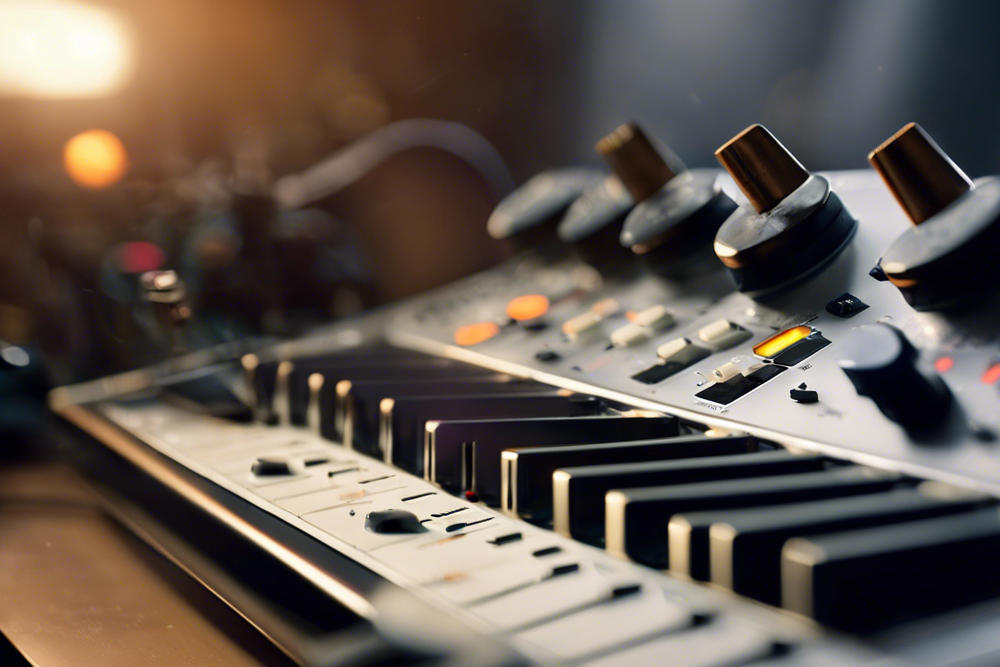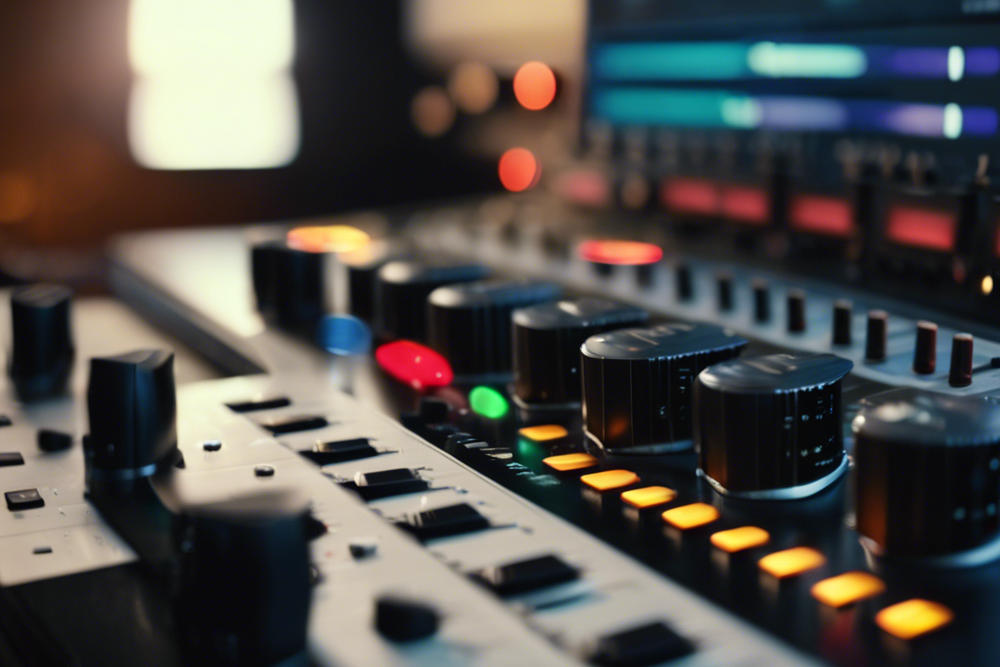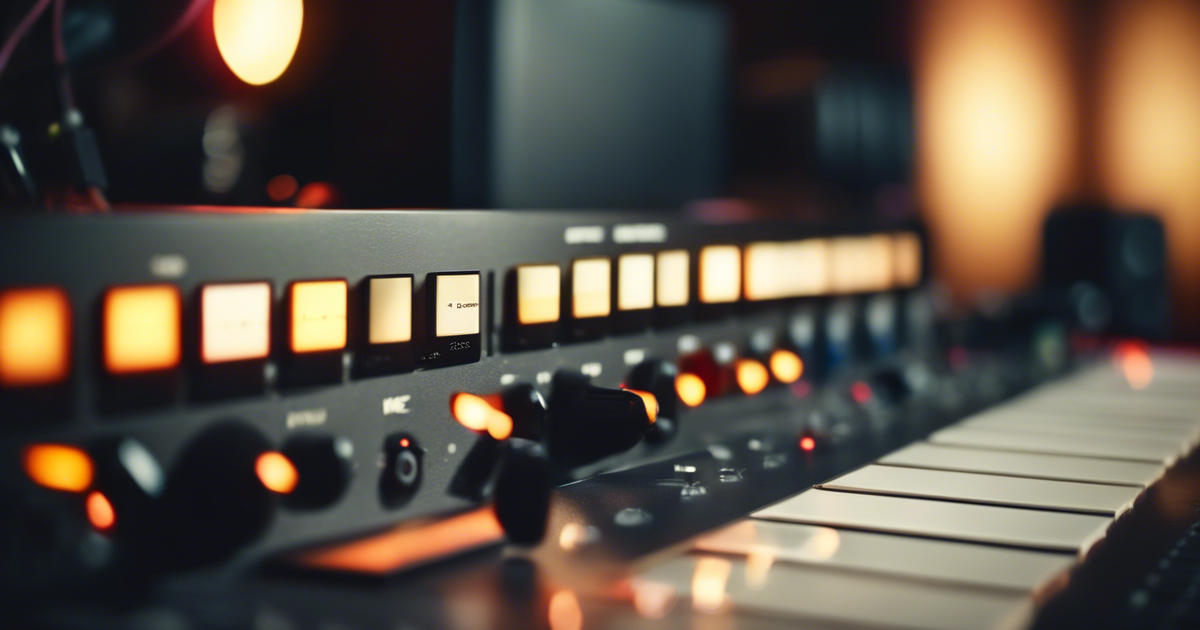Estimated reading time: 13 minutes
As a musician or audio enthusiast, I’ve always been fascinated by the world of audio interfaces. These nifty little devices have the power to transform your computer into a professional-grade recording studio, allowing you to capture high-quality audio with ease. If you’re new to the world of audio interfaces, don’t worry – I’ve got you covered! In this comprehensive guide, I’ll walk you through everything you need to know to get started.
Table of contents
- What is an Audio Interface and Why Do You Need One?
- Understanding the Components of an Audio Interface
- Setting Up Your Audio Interface
- Configuring Audio Settings for Optimal Sound Quality
- Different Types of Inputs on an Audio Interface
- Using Microphone Inputs
- Using Instrument Inputs
- Understanding Analog and Digital Signals
- Exploring Output Devices
- Understanding Buffer Size and Latency
- Using Phantom Power
- Troubleshooting Common Audio Interface Issues
- Tips for Recording and Producing Music with an Audio Interface
- Audio Interface Options for Different Budgets and Needs
- Audio Interface Setup for Beginners – Video
- Conclusion
- FAQs
What is an Audio Interface and Why Do You Need One?
An audio interface is a hardware device that connects your microphones, instruments, and other audio sources to your computer. It acts as a bridge between the analog world of sound and the digital world of your computer, converting those analog signals into digital data that your computer can understand and process.
Without an audio interface, you’d be limited to the built-in sound card in your computer, which often falls short when it comes to recording high-quality audio. An audio interface provides superior sound quality, more input and output options, and advanced features that can take your audio production to the next level.
| Feature | Description |
|---|---|
| Definition | A hardware device that connects microphones, instruments, and other audio sources to a computer. |
| Primary Function | Converts analog signals into digital data for the computer to process. |
| Benefits over Sound Card | Provides superior sound quality, more input/output options, and advanced features. |
| Use Cases | Ideal for recording high-quality audio for music production, podcasts, and professional audio work. |
| Common Components | Inputs (XLR, 1/4″ TRS, DI), outputs (1/4″ TRS, RCA, XLR), connectivity (USB, Thunderbolt, FireWire), knobs, buttons |
| Importance | Essential for achieving professional-grade audio recording and production. |
Understanding the Components of an Audio Interface
Audio interfaces come in a variety of shapes and sizes, but they generally share a common set of components. These include:
- Inputs: These are the ports where you’ll connect your microphones, instruments, and other audio sources. Common input types include XLR, 1/4″ TRS, and DI (direct input) jacks.
- Outputs: These are the ports where you’ll connect your speakers, headphones, or other output devices. Typical output types include 1/4″ TRS, RCA, and XLR connectors.
- Connectivity Options: Audio interfaces can connect to your computer via USB, Thunderbolt, or even FireWire, depending on the model.
- Knobs and Buttons: Most audio interfaces feature knobs and buttons for adjusting input levels, monitoring volume, and accessing various settings and features.
Understanding the components of your audio interface will help you set it up and use it effectively.
Setting Up Your Audio Interface
Getting your audio interface up and running is a straightforward process. Here’s what you’ll need to do:
- Connect the Cables: Start by connecting your audio sources (microphones, instruments, etc.) to the input ports on your interface using the appropriate cables (XLR, 1/4″ TRS, etc.).
- Connect the Interface to Your Computer: Use the provided USB, Thunderbolt, or FireWire cable to connect your audio interface to your computer.
- Install the Drivers: Most audio interfaces come with software drivers that you’ll need to install on your computer. Follow the instructions provided by the manufacturer to ensure a smooth installation.
- Configure the Audio Settings: Once the drivers are installed, you’ll need to configure your audio settings in your computer’s sound settings or your digital audio workstation (DAW) software.
By following these steps, you’ll have your audio interface up and running in no time.
Configuring Audio Settings for Optimal Sound Quality
To get the best possible sound quality from your audio interface, it’s important to configure your audio settings properly. Here are some key settings to focus on:
- Sample Rate: This determines the number of audio samples taken per second. Higher sample rates (like 44.1 kHz or 48 kHz) result in better sound quality, but also require more processing power.
- Bit Depth: This refers to the number of bits used to represent each audio sample. A higher bit depth (like 24-bit) provides a wider dynamic range and better sound quality.
- Buffer Size: The buffer size determines how much audio is processed at a time. A smaller buffer size reduces latency (the time it takes for the audio to be processed), but requires more processing power.
Experiment with these settings to find the optimal balance between sound quality and system performance for your specific setup.
Different Types of Inputs on an Audio Interface
Audio interfaces typically offer a variety of input options to accommodate different types of audio sources. Here are some of the most common input types:
- Microphone Inputs (XLR): These are the standard inputs for connecting professional-grade microphones, which often use XLR connectors.
- Instrument Inputs (1/4″ TRS): These inputs are designed for connecting guitars, keyboards, and other musical instruments.
- Line Inputs (1/4″ TRS or RCA): These inputs are used for connecting external audio sources like synthesizers, drum machines, or even consumer-grade audio equipment.
- DI (Direct Input) Inputs: These specialized inputs are often used for connecting electric guitars or bass guitars directly to the interface, bypassing the need for an amplifier.
Familiarize yourself with the input options on your audio interface and choose the appropriate connections for your audio sources.

Using Microphone Inputs
When it comes to recording high-quality audio, microphone inputs are often the most crucial. Here’s how to use them effectively:
- Choose the Right Microphone: Select a microphone that’s suitable for your recording needs, whether it’s a dynamic microphone for vocals or a condenser microphone for more delicate instruments.
- Adjust the Input Levels: Use the gain knob on your audio interface to adjust the input level for your microphone. Aim for a strong, clean signal without clipping or distortion.
- Experiment with Microphone Placement: The positioning of your microphone can have a significant impact on the sound quality. Try different placements and distances to find the sweet spot.
Mastering the use of microphone inputs is a crucial step in achieving professional-sounding audio with your audio interface.
Using Instrument Inputs
Connecting your instruments, such as guitars, keyboards, or drum machines, to your audio interface is a straightforward process. Here’s what you need to know:
- Connect the Instrument: Use the appropriate cable (usually a 1/4″ TRS or DI cable) to connect your instrument directly to the instrument input on your audio interface.
- Adjust the Input Level: Use the gain knob on your audio interface to set the appropriate input level for your instrument. Avoid clipping or distortion.
- Consider Direct Input (DI) Boxes: For electric guitars or basses, using a DI box can help you achieve a cleaner, more balanced signal.
Proper setup and level adjustment for your instrument inputs will ensure that your audio interface captures your playing with maximum fidelity.
Understanding Analog and Digital Signals
At the heart of an audio interface is the process of converting analog audio signals into digital data that your computer can understand. This is known as analog-to-digital conversion (ADC).
- Analog Signals: Analog audio signals are continuous waveforms that represent the physical vibrations of sound. These signals are what microphones and instruments produce.
- Digital Signals: Digital audio signals are a series of discrete numerical values that represent the original analog waveform. Your computer processes and stores audio in this digital format.
- The Conversion Process: Your audio interface’s analog-to-digital converters (ADCs) take the incoming analog signals and convert them into high-quality digital data that can be processed by your computer.
Understanding this conversion process is key to appreciating the role of an audio interface in your audio production workflow.
Exploring Output Devices
In addition to handling your audio inputs, your audio interface also plays a crucial role in delivering your audio to the outside world. Here’s a look at the output options:
- Studio Monitors: These are specialized speakers designed for accurate, high-fidelity audio playback. Connecting your audio interface to a pair of studio monitors is essential for monitoring your recordings and mixes.
- Headphones: Audio interfaces often provide dedicated headphone outputs, allowing you to listen to your audio with great detail and clarity, without disturbing others.
- Additional Output Devices: Depending on your needs, you may also connect other output devices like external speakers, soundbars, or even audio interfaces for multi-channel setups.
Proper setup and configuration of your output devices will ensure that you can accurately hear and evaluate the audio you’re working with.
Understanding Buffer Size and Latency
One important aspect of using an audio interface is understanding the concept of buffer size and its impact on latency.
- Buffer Size: The buffer size determines the amount of audio data that’s processed at a time. A smaller buffer size results in lower latency (the time it takes for the audio to be processed), but requires more processing power from your computer.
- Latency: Latency is the time it takes for the audio signal to travel from the input of your audio interface to the output. High latency can cause issues like delayed monitoring or difficulty playing in time with a recording.
Finding the right balance between buffer size and latency is crucial for achieving optimal performance from your audio interface, especially when recording or playing live. Experiment with different settings to find the sweet spot for your specific setup.

Using Phantom Power
Many condenser microphones require a source of phantom power to operate. Phantom power is a feature found on most professional-grade audio interfaces that provides a small amount of DC voltage to the microphone’s internal electronics.
- Activating Phantom Power: Look for a dedicated phantom power button or switch on your audio interface. This will enable the necessary voltage to power your condenser microphone.
- Compatibility: Make sure your microphone is compatible with phantom power before activating it. Applying phantom power to an incompatible microphone can potentially damage the device.
Proper use of phantom power is essential for getting the best performance from your high-quality condenser microphones.
Troubleshooting Common Audio Interface Issues
Even the best audio interfaces can encounter occasional issues. Here are some common problems and how to address them:
- No Sound: Check your cable connections, input/output settings, and computer audio settings to ensure your audio interface is properly configured.
- Crackling or Distortion: This could be caused by a variety of factors, such as incorrect input levels, buffer size issues, or even hardware problems. Experiment with your settings to isolate the issue.
- Latency Problems: Adjust your buffer size and other performance settings to minimize latency and ensure smooth, real-time monitoring.
- Driver or Software Issues: If you’re experiencing compatibility problems, make sure you have the latest drivers installed and that your software is up-to-date.
Don’t be afraid to consult the manufacturer’s documentation or reach out to their support team if you encounter any persistent issues with your audio interface.
Tips for Recording and Producing Music with an Audio Interface
Now that you have a solid understanding of how to use an audio interface, here are some tips to help you get the most out of it in your music production and recording workflow:
- Experiment with Microphone Placement: The positioning of your microphones can have a significant impact on the recorded sound. Try different angles, distances, and techniques to find the perfect setup.
- Monitor Your Levels: Keep a close eye on your input and output levels to avoid clipping or distortion. Adjust the gain as needed to maintain a clean, balanced signal.
- Use External Hardware: Integrate other audio equipment, like outboard preamps, compressors, or effects units, to enhance your sound and expand your creative possibilities.
- Optimize Your Computer’s Performance: Make sure your computer is optimized for audio processing by closing unnecessary programs, disabling power-saving features, and allocating resources to your DAW software.
- Develop Your Listening Skills: Use your audio interface’s high-quality monitoring capabilities to critically listen to your recordings and mixes, and make informed decisions about the sound you’re creating.
By following these tips, you’ll be well on your way to unlocking the full potential of your audio interface and creating professional-sounding music.
Audio Interface Options for Different Budgets and Needs
Audio interfaces come in a wide range of prices and feature sets, catering to various budgets and recording needs. Here’s a quick overview of some common options:
- Entry-Level Interfaces: These affordable interfaces, often costing under $200, are a great starting point for beginners. They typically offer 2-4 inputs and basic connectivity options.
- Mid-Range Interfaces: Priced between $200 and $500, these interfaces provide more advanced features, such as additional inputs/outputs, better converters, and more connectivity options.
- Professional-Grade Interfaces: For serious music producers and engineers, high-end interfaces (typically $500 and above) offer superior sound quality, advanced connectivity, and extensive feature sets to meet the demands of professional-level recording and production.
When choosing an audio interface, consider your specific needs, such as the number of inputs/outputs, connection type (USB, Thunderbolt, etc.), and any specialized features (like built-in preamps or DSP capabilities) that may be important for your workflow.If you’re ready to take your audio production to the next level, I encourage you to explore the wide range of audio interfaces available and find the one that best fits your needs and budget. With the right audio interface, you’ll be able to capture and create high-quality audio with ease.
Audio Interface Setup for Beginners – Video
Conclusion
In conclusion, an audio interface is a valuable tool for musicians and audio enthusiasts looking to capture high-quality audio. It acts as a bridge between analog sound sources and digital recording software, providing superior sound quality and advanced features. Understanding the components of an audio interface and properly setting it up are crucial for optimal performance. Configuring audio settings, familiarizing oneself with different input types, and mastering the use of microphone and instrument inputs are key steps in achieving professional-sounding audio with an audio interface. With the right equipment and knowledge, anyone can transform their computer into a powerful recording studio.
Related Posts
- How to Clear a Sample? A Step-by-Step Guide for Musicians and Producers
- How to Make Loops: A Guide for Music Producers
- What Are 808 Beats? From Underground Grooves to Mainstream Melodies
- What is an Interlude in an Album? Unraveling the Musical Magic Between Tracks
- What Makes a Good Song? Unlocking the Mysteries of Memorable Music
- How to Sidechain? A Step-by-Step Guide to Achieve that Perfect Pump
FAQs
An audio interface is a device that connects microphones, instruments, and other audio sources to your computer, converting analog signals to digital data. It is essential for high-quality recording, offering superior sound quality, more input/output options, and advanced features compared to a computer’s built-in sound card.
To set up your audio interface, connect your audio sources to the input ports, then connect the interface to your computer using the provided cable. Install the necessary drivers, and configure your audio settings in your computer’s sound settings or digital audio workstation (DAW) software.
Key settings include sample rate (higher rates like 44.1 kHz or 48 kHz offer better quality), bit depth (24-bit provides a wider dynamic range), and buffer size (smaller sizes reduce latency but require more processing power). Adjust these to balance sound quality and system performance.
Choose a suitable microphone for your recording needs, adjust the input levels using the gain knob to get a strong, clean signal without clipping, and experiment with microphone placement to find the optimal sound quality. Proper use of microphone inputs is crucial for professional recordings.
Common issues include no sound, crackling, or latency problems. Check cable connections, input/output settings, and ensure drivers are up-to-date. Adjust buffer size for latency issues and consult the manufacturer’s documentation or support if problems persist.
